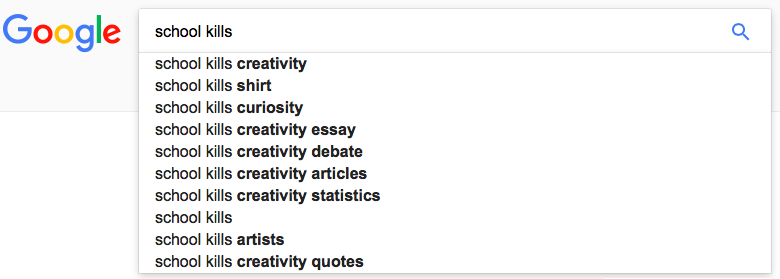Type “schools kill” in your Google bar and the first ten things that populate the autocomplete suggestion bar revolve around the word “creativity”. Sir Ken Robinson has a lot to do with that. He did have a wide-reaching and powerful Ted Talk on the topic, but the “phrase” would not be as popular if it weren’t true. In kindergarten, the students come in and learn things like how to spell their name, how to count, and how to walk in a line. And then when they get older and move on, the “walking in line” part along with the writing their name on the line and other inconsequential matters take precedence over the actual learning. This is really what happens in school. Inevitably, obedience and following a prescribed manner of demonstrating “understanding” outweighs any creative, different, or divergent thought processes. Gradually, from kindergarten to third grade, and then onto the 6th grade and eventually into high school, we craft a model of schooling that is molded in the shape of the epitome of educational institutions – the university.
Sorry to say, but, we are following the wrong leader.
I graduated with a double major in history and English from one of the most prestigious universities in North America, and got somewhat decent grades doing so. But I barely remember shit from those classes. However, I did learn how to cram, memorize key concepts, and regurgitate ideas back onto a piece of paper when a paper or exam was pending.
I did learn how to alienate my creativity, repress contrary ideas, and speak once or twice in a class – not because I wanted to participate, but because I knew that by participating the teacher may remember may face when I inevitably asked for an extension on an assignment. In university, I was subliminally learning more about the nature of schooling than I was about the actual content of the school work. This is what school eventually teaches us.
But university is the standard for meritocratic “intelligence”. People are judged based on their ability to pass university courses and earn degrees. And the more degrees you earn, supposedly, the “smarter” you are and subsequently, the more life opportunities you will have. For the most part, the reasons are sensible. I want my doctor to have gone through the academic rigor required in order for him to attain the qualifications to operate on me. I don’t want to see my accountant using a calculator when he has to multiply 8 by 3. And I don’t want my son to learn how to write from a teacher who does not know what a noun and a verb are. The university rightfully stands as the model for academic rigor and integrity within any functioning society. But that does not mean that high schools, and by virtue of extension, elementary schools, should follow how they teach learners and attempt to instill learning. Unfortunately, because they do, a lot of brilliant youngsters never make it to higher education.
Ken Robinson speaks about a longitude study that was conducted with children between the ages of 4 to 15 on “divergent thinking”. Divergent thinking is an “essential capacity” for creativity. It is the ability to see “multiple answers” to a specific question. The study found that while 98 percent of kindergarten children scored at a genius level of divergent thinking, it drastically dropped as they got older. This is where I’m supposed to write at length about how schools kill creativity. I ain’t gonna though. I’ll leave that understanding up to you smart folks.
Students should know their times tables by the third or fourth grade and also know how to write a proper sentence and paragraph by roughly around the same age. But if they do not, it is our task to teach them these skills. Read that last sentence again, we must teach essential skills that are tied to the curriculum and not merely assess students’ understanding of concepts based on whether or not they come into your classroom with those skills. For whatever reason, that doesn’t seem to be happening too often in our high schools. Students “earn” a two percent in high school math classes while being taught by math “specialists”. Why? Because the high school is following the ‘sink or swim’ model of university. High school need not be the proving ground for ultimate academic and intellectual integrity. High school must still provide love, care, and learning…like actual learning, for the teenagers that they teach. That is their small role along the educational continuum.
When one seeks to become a professional baseball player he starts by playing tee-ball. Then he plays baseball where the bases are not 90 feet apart but maybe 60. And the pitcher learns to throw from maybe 30 feet before he eventually gets to 66.6 feet. Full games for a youngster start at 5 innings, then go to 7, and finally to 9. Baseball has an understanding of how the human is meant to develop. They don’t copy the MLB and expect 12-year-olds to perform like 19-year-olds. They scaffold their game through modeling progressive implementations that readies youngsters for the totality of their standards. Same with basketball, you don’t play on a 94-foot court until you get to a city championship or to college. But in education, we copy youth “learning” with the exact same dimensions, standards, and unapologetic criteria that is found in our “pro leagues” – the university. We can follow the leader, but it would be more beneficial to not. And instead, teach in incremental steps rather than copying the same exact conditions of our highest establishment.
[share title=”Share this Post” facebook=”true” twitter=”true” google_plus=”true”]

